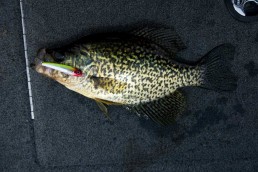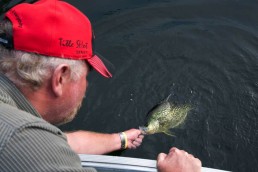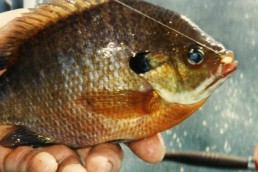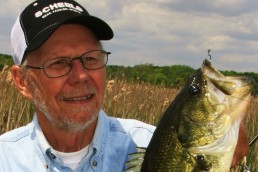Big Panfish Respond to Hard Baits Like True Predators
SHARE THIS POST
Pint-sized? Sometimes, but not always. Timid? Guess again.
Despite being small in comparison to many sport fish, panfish are aggressive predators. For a fun and productive way to catch these critters, use hard baits this year.
The category of hard baits includes crankbaits, minnowbaits and jerkbaits. All are excellent for covering water, and when retrieved, hard baits provide flash, vibrations and sometimes even rattles. Their profile and paint patterns mimic panfish forage like minnows, crayfish and insects. The best lures are 1 to 3 inches in length. Floating, suspending and sinking lures let you fish a range of depths and types of cover. Lastly, hard baits get the attention of, and catch, big panfish. Here’s a guide to using them through the open-water seasons:
Spring
Sunfish, crappies and perch move to shallows in spring to spawn. Sight-fishing with cranks or minnowbaits is an exciting and effective way to target panfish on calm, sunny days.
Shallow rock and sand bays mixed with sparse weeds are prime bluegill and pumpkinseed areas. When you spot a school, cast a floating crankbait or minnowbait past them. Work the bait to the pod’s periphery, steering it toward larger fish. Use a stop-and-go retrieve; the pause triggers hits, hooking pecking sunfish. Stopping a floating bait helps avoid shallow-water snags.
Crankbaits are also deadly for crappies relating to shallow cover. Make short, accurate casts to open areas in bulrushes, laydowns or sunken wood stumps. Use a lightweight bait when tossing tight to cover. This reduces splash and prevents spooking fish.
Hard baits are also perfect for spring shore fishing. You’ll intercept a variety of panfish fan casting from the water’s edge. Canals and locks absorb and radiate the sun’s heat into the water, attracting all species of panfish. Backwaters, bays and tributaries are other places to try from shore.
Summer
Hard baits still shine for panfish come summer. To fish the deeper areas, use countdown-sinking cranks. Suspending or deep-diving cranks are also effective.
Drifting weed flats is a good strategy to cover water for panfish. This tactic worked for my fishing partner Pete Kelly and I last summer. We skimmed over a weed flat in a canoe, tossing cranks. We boated dozens of eager, biting bluegills during a short evening fish.
Working deep weed edges catch crappies, perch, bluegills and pumpkinseeds. Concentrate on inside and outside turns of weedlines. Fish areas where weeds intersect structures, like a rock point or a sunken log. Perch hit any profile of crankbait. Don’t be afraid to upsize your offering come summer; jumbos hit baits 4 inches or larger.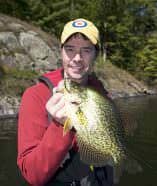
Panfish, especially crappies, suspend off of weedlines in summer. Cast baits to open-water areas adjacent to weeds. Trolling cranks along edges and structure is another effective way to cover water.
Are you enjoying this post?
You can be among the first to get the latest info on where to go, what to use and how to use it!
Long points leading into deep water hold suspending crappies, bluegills and perch. Watch your electronics. Panfish feed up, so work baits higher than where you mark them.
Docks are other good panfish spots. I’ve taken plenty of bluegills from shallow-water docks. Toss baits along the edges and inside of large docks. Try a twitch-pause retrieve with a floating bait.
Public docks and marinas over deep water can hold good populations of perch. Concentrate on working dock pilings and openings.
Well-lit public docks become feeding zones for crappies at night. The illumination attracts insects, baitfish and the crappies. Use bright-colored or silver minnowbaits or floating cranks. Cast to surface feeding activity, and slow down the retrieve once dark arrives.
Fall
Locating healthy weeds or rock and wood areas near breaks are two good strategies to find panfish in autumn. Deep weeds are the last to die off and hold sunfish, perch and crappies.
Work weed edges and open water as you would in summer to pick off all species of panfish. Sinking crankbaits and suspending jerkbaits worked with a sluggish retrieve are good cold-water baits.
Lay-downs are another structure worthy of casting in summer and early autumn. Wood holds bluegills and crappies. This snag-heavy cover demands accurate casts. Cast a floating crank around the wooden perimeter, then retrieve the bait down the main trunk, pausing frequently to trigger hits while avoiding snags.
Bulrushes and fallen timber will hold panfish in sunny, warm conditions. Explore tributaries as well. Like in spring, walking the water’s edge and casting a hard bait is a good strategy.
Try hard baits this year for sunfish, crappies and perch. They’re effective for working various types of cover. More important though, cranks catch big panfish.
Tackle
Toss cranks with ultralight- to light-action-spinning rods. Longer rods above 6 feet improve casting distance and helps steer baits to fish and away from snags when sight-fishing. Short rods, between 5 and 6 feet, are easier to use in tight cover. Use 4- to 6-pound-test line.
MWO
SHARE THIS POST
Did you enjoy this post?
You can be among the first to get the latest info on where to go, what to use and how to use it!
Tim Allard
Tim Allard is a full-time outdoor journalist and author and photographer of the multi-award-winning book, Ice Fishing––The Ultimate Guide. Follow him on Instagram @timallardtips.
